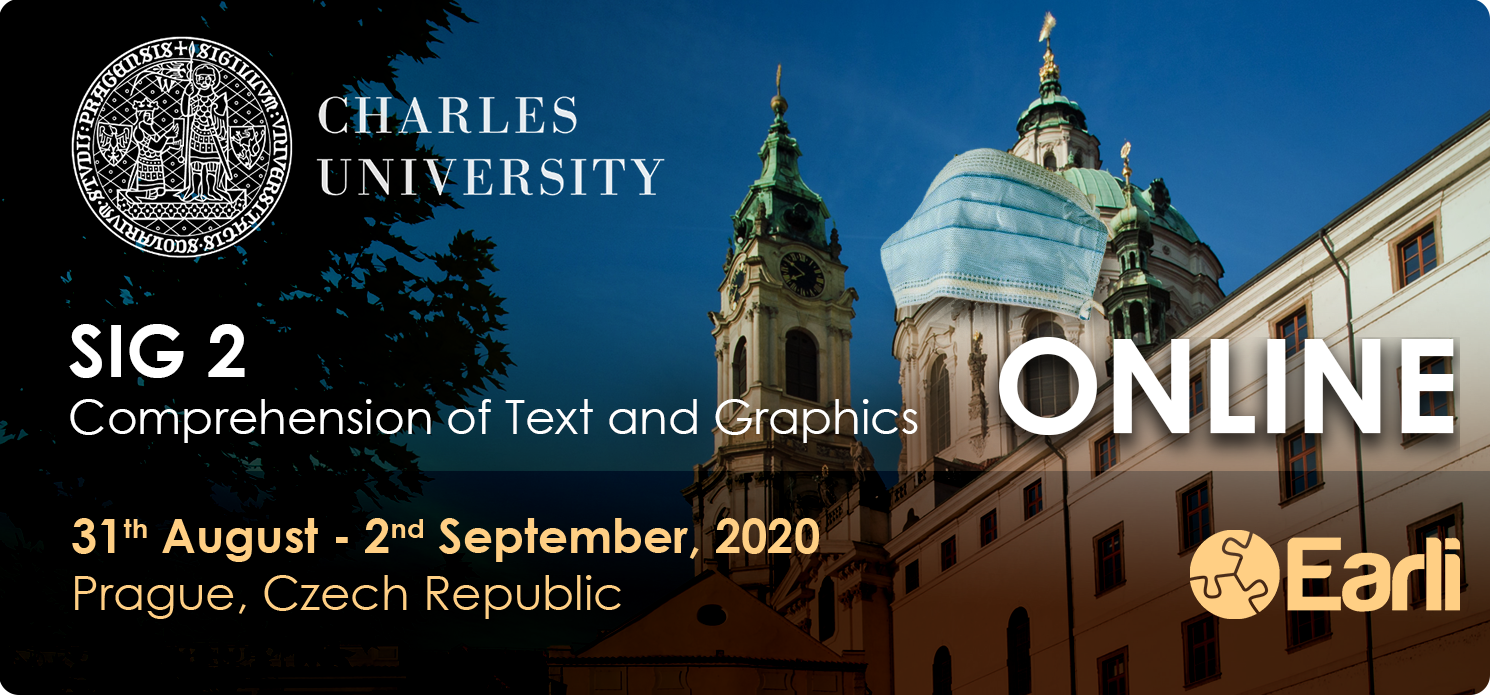
NEWS
Dear colleagues,
based on the survey's results we have decided to arrange the SIG 2 Conference 2020 in completely online format. It will be classical online conference on the ZOOM platform with slots and Q&A right after the slots.
Conference final schedule is out
You can find the schedule for this year's SIG 2 virtual conference here.
Please keep in mind, that minor additional changes may occur.
Registration
Please register till 15th of July 2020.
The registration is done via this form (not the EARLI system) and there is no fee.
Up to two people can register for each submitted paper. In case this is not sufficient for your group, please drop us an email at SIG2@earli.org (the number of people is limited due to the license limitations for the online platform).
Presenting formats
Participants of full papers give their talks live in their pre-scheduled slots (the conference's time zone is Central European Summer Time).
Participants can pre-record their lectures if they wish and put them online a couple of days before the event (we will facilitate sharing, but not help with the recording); if participants who pre-recorded their talks want, we could also stream their talks in their slots (but they can do both: pre-record and speak live).
There will be special presentation slots for posters. We will send you detailed information later on, but our preliminary idea is that each poster will have a 5 min lecture slot (i.e., a quick summary talk) and an answer slot; it will be possible to pre-record the quick summary talk; we will share posters in electronic form beforehand.
There will be slots for round table contributions; we will send you detailed information as regards round tables later on, but it will not be possible to pre-record these contributions due to the nature of the format.
Those having time-zone issues can express interest in specific talks beforehand till 15th of August and we will try to do our best to make the schedule to reflect this; if this won't be possible, these talks will, at least, have two answer slots (i.e., the second answer slot for those with "time-zone" issues).
We will provide preliminary schedule of the conference and share contributions (pdf files) among those who registered in the second half of July.
THEME
Interactivity in text and graphics research: from self-paced slides to educational games
Interactivity is a multifaceted phenomenon. Self-paced slides, non-linear hypermedia, learning environments featuring multiple documents, e-books, tutoring systems, educational games… they all (and not only they!) are interactive.
Whenever a system reacts to user input, there you have it: interactivity. It is commonplace in present-day learning materials, yet its many forms are poorly understood. We would thus like to draw attention to interactivity this year by calling the next SIG2 conference “Interactivity in text and graphics research: from self-paced slides to educational games”.
TOPICS
Please, note, that the central theme is meant to inspire submission, but not to limit their scope. All proposals that fit within the domains of the SIG are most welcome. Typical topics include learning from:
- Texts
- Texts with pictures
- Graphical representations
- Multiple documents
- Hypermedia
- Animations and videos
- Simulations and games
- …
DATES
Save the Date
-
January 6th 2020Submission system opens
-
February 14th 2020 at 23h59 (UTC -12)EXTENDED Deadline for submissions
-
April 10th 2020Notificaion of review decisions
-
July 15th 2020Registration deadline
-
Monday 31th August - Wednesday 2nd September 2020SIG 2 Meeting ONLINE
SUBMISSIONS
EXTENDED Submission deadline
February 14th 2020 at 23h59 (UTC -12). The submission system opens 6th January 2020.
All submissions will be reviewed by at least two members of the scientific committee. You will be notified of the results of the reviewing process by April 10th 2020. Proposals should be submitted through the EARLI submission system (https://conference.earli.org)
Submission Format
Two main submission formats are proposed:
1) Paper proposal (for poster or oral presentation)
This is the standard format that provides participants the opportunity to present and discuss the results from recently completed research as well as work in progress in late stages. Paper proposals should be no longer than 1000 words, plus abstract between 80 and 150 words and, in addition to that, up to three tables or images.
The paper proposals that receive the most favorable reviews and that fit well within the meeting’s scope will be allowed a 20 minutes oral presentation (15 minutes presentation and 5 minutes discussion). As we try to keep the conference single tracked, acceptation for oral presentations will be highly selective. Other paper proposal that fall within the scope of the meeting and are of sufficient scientific quality will be allowed a poster presentation.
Note that if you submit several paper proposals as first author, only one will be allowed an oral presentation (the one that receives the highest review scores), the other proposals being then accepted as posters (it is possible to be first/presenting author on one oral paper and one round-table).
The poster sessions will be of substantial length and scheduled at convenient times during the conference, making this a lively and interactive presentation format. Note that you can choose during the submission process that your proposal be a poster presentation (for example for new ideas or work in progress).
2) Round-table proposal (parallel sessions – 1h30)
Round-table sessions offer opportunities for a more discursive exploration of research issues. The presenters explain their ongoing research, and invite the participants to discuss data or to solve a research issue or problem. This may well involve discussions of work in progress. All round-table proposals that allow for sufficient discussion and that are within the scope of the meeting will be allowed a round-table presentation.
Each round-table session will consist of three conceptually linked projects. Each presenter has 10 minutes to introduce his/her project and raise one or two open questions. Twenty minutes at least are intended for discussion.
You can submit a) either an individual contribution (we will cluster these contributions to round-table sessions) or b) the whole round-table session. In the latter case, please, submit four individual papers in total: one as the session summary and three as individual talks (one for each talk). In this latter case, please, make sure all four contribution titles start with the round-table session’s name, e.g., “Rountable X: summary”; “Rountable X: Topic A”; “Rountable X: Topic B”; “Rountable X: Topic C”.
JURE mentoring program
All students presenting their work at the conference are invited to participate in the mentoring program (a wish to participate can be expressed when registering for the conference). In this program, they will receive constructive feedback on their work from one of the senior researchers attending the conference.
We will also have JURE Awards for the best paper and the best poster (to be eligible, first author must be a student at the time of submission).
Proceedings
Accepted presentations will be included in the electronic proceedings provided that at least one author is registered to the conference. Note that the proceedings do not constitute publishing, i.e., conference papers can be, in longer forms, submitted to journals (or be already published).
KEYNOTES

Jan L. Plass
New York University
Designing for Engagement in Interactive Learning Environments
Research has investigated a number of ways of how to enhance learning from text and graphics. Interactivity, defined here as the reciprocal activity between a learner and a multimedia learning system, in which the [re]action of the learner is dependent upon the [re]action of the system and vice versa, is one of the mechanisms that have been found to facilitate learning. In this talk I will present the Integrated Model of Multimedia Interactivity INTERACT (Domagk, Schwartz, & Plass, 2010), which links engagement to interactivity. I will argue that we should consider four different types of engagement as the goals of designing interactive learning environments. These include affective engagement, cognitive engagement, physical engagement, and socio/cultural engagement. I will discuss research and examples for each of these types of engagement and show how they can be used to enhance learning outcomes in the context of simulations and games.
Jan L. Plass, Ph.D., Paulette Goddard Chair in Digital Media and Learning Sciences, and Professor in the Steinhardt School of Culture, Education, and Human Development at New York University, is the founding director of the CREATE Consortium for Research and Evaluation of Advanced Technology in Education and co-directs the Games for Learning Institute. Dr. Plass’ research is at the intersection of cognitive science, learning sciences, and design, and seeks to enhance the effectiveness of interactive visual environments for learning. His current focus is on studying cognitive, social, and emotional design patterns for simulations, games, and VR for learning math, science, and AI, and games for cognitive skills development. This work has been funded by numerous research grants from federal agencies, private foundations, and corporations. He has published his work widely in academic journals, edited volumes, and conference proceedings. Dr. Plass is the lead editor of the Handbook of Game-based Learning (MIT Press, 2020). He frequently presents his work nationally and internationally and helps designers improve the impact of their products by applying cognitive science and learning sciences principles.

Zsofia K. Takacs
Institute of Education, Eötvös Loránd University, Hungary
21st century children's storybooks: the effects of multimedia and interactive features in digital storybooks
Illustrations in picture storybooks have a very important role: they support children’s story comprehension if they are congruent with the story (Takacs & Bus, 2018). With the spread of digital storybooks, such as story apps, children encounter story presentations with further multimedia and interactive enhancements. In a meta-analysis we found that multimedia elements significantly improve children’s comprehension and word learning, while interactive features are not beneficial (Takacs, Swart, & Bus, 2015). More specifically, it seems that animated illustrations including motion and zooming is especially helpful (Takacs & Bus, 2016), while music and background sounds are not (Sari et al., 2019). Eye-tracking data shows that motion attracts children’s attention to specific details in the illustrations, which might be a key mechanism for the benefits of animation for children’s story comprehension (Takacs & Bus, 2016).
SCIENTIFIC COMMITTEE
- Shaaron Ainsworth, University of Nottingham
- Franck Amadieu, University of Toulouse
- Anne Bellert, Southern Cross University
- Sandra Berney, University of Geneva
- Mireille Bétrancourt, University of Geneva
- Jean-Michel Boucheix, University of Dijon
- Ivar Bråten, University of Oslo
- Cyril Brom, Charles University in Prague
- Raquel Cerdán, University of Valencia
- Jennifer Cromley, Illinois University
- Bjorn de Koning, University of Rotterdam
- Erica de Vries, University of Grenoble Alpes
- Juliette Désiron, University of Geneva
- Alexander Eitel, University of Giessen
- Sarah Fabrikant, University of Zurich
- Manuela Glaser, Leibniz-Institut für Wissensmedien, Tübingen
- Tim Höffler, Leibniz Institute for Mathematics and Science Education, Kiel
- Eric Jamet, Université de Rennes 2
- Ondřej Javora, Charles University in Prague
- Carolien Knoop-van Campen, Radboud University Nijmegen
- Tim Kühl, University of Mannheim
- Janina Lehmann, University of Ulm
- Detlev Leutner, University of Duisburg-Essen
- Marlit Lindner, Leibniz Institute for Mathematics and Science Education, Kiel
- Fons Maes, Tilburg University
- Lucia Mason, University of Padova
- Martin Merkt, German Institute for Adult Education Bonn
- Gaëlle Molinari, Distance University Switzerland
- Juliane Richter, Leibniz-Institut für Wissensmedien, Tübingen
- Tobias Richter, University of Würzburg
- Jean-François Rouet, LACO-CNRS, Poitiers
- Ladislao Salmeron, University of Valencia
- Katharina Scheiter, Leibniz-Institut für Wissensmedien, Tübingen
- Florian Schmidt-Borcherding, University of Bremen
- Cornelia Schoor, University of Bamberg
- Anne Schüler, Leibniz-Institut für Wissensmedien, Tübingen
- Neil Schwartz, California State University at Chico
- Tina Seufert, University of Ulm
- Helge I. Strømsø, University of Oslo
- Huib Tabbers, University of Rotterdam
- Christian Tarchi, University of Florence
- Marije van Amelsvoort, Tilburg University
- Jan van der Meij, University of Twente
- Eduardo Vidal-Abarca, University of Valencia
VENUE
The 2020 SIG2 meeting is operated by Advanced Multimedia Learning Laboratory at Charles University, Prague.
The platform for the online conference will be ZOOM.
ORGANIZING COMMITTEE
Cyril Brom (conference chair, SIG coordinator)
Alexander Eitel (SIG coordinator)
Mireille Betrancourt (former SIG coordinator)
Ondřej Javora (JURE SIG coordinator)
Janina Lehman (former JURE SIG coordinator)
contact: SIG2@earli.org
